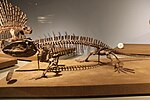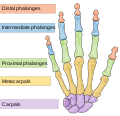Evolution of tetrapods). These ancestral tetrapods had never left the water, and were thus primarily aquatic, like modern fishes. Secondary aquatic adaptations...
10 KB (1,094 words) - 17:04, 7 August 2024
evolution of tetrapods began about 400 million years ago in the Devonian Period with the earliest tetrapods evolved from lobe-finned fishes. Tetrapods (under...
67 KB (7,975 words) - 22:12, 15 November 2024
partly aquatic. However, most tetrapod species today are amniotes, most of which are terrestrial tetrapods whose branch evolved from earlier tetrapods early...
104 KB (10,592 words) - 16:15, 21 November 2024
fish, and weakly developed bones, which are seen in many other secondarily aquatic tetrapods. In 1940, paleontologists Alfred Romer and Llewellyn Ivor Price...
9 KB (892 words) - 15:44, 28 April 2024
Dactyly (section Aquatic tetrapods)
Polydactyly in early tetrapod aquatic animals, such as in Acanthostega gunnari (Jarvik 1952), one of an increasing number of genera of stem-tetrapods known from...
17 KB (1,932 words) - 20:00, 5 August 2024
exclusive of other tetrapods. Instead, they consistute an evolutionary grade (a paraphyletic group), ancestral to living tetrapods such as lissamphibians...
68 KB (7,456 words) - 20:01, 18 November 2024
includes finned and limbed tetrapods that are more closely related to living tetrapods than to living lungfishes." Tetrapods evolved from animals with...
9 KB (993 words) - 12:15, 6 September 2024
some tetrapods started to evolve towards a reptilian condition. Some of these tetrapods (e.g. Archeria, Eogyrinus) were elongate, eel-like aquatic forms...
28 KB (2,968 words) - 14:17, 19 November 2024
and rostrum of hupehsuchians have been compared to many other secondarily aquatic tetrapods such as plesiosaurs, whales, and the early marine bird Hesperornis...
24 KB (2,946 words) - 23:52, 19 November 2024
other tetrapods somewhere during Romer's gap, when the adult tetrapods became fully terrestrial (some forms would later become secondarily aquatic). The...
46 KB (3,673 words) - 11:56, 22 November 2024
sarcopterygians, prototetrapods, aquatic stem tetrapods (or "fishapods"), amphibian true tetrapods, and amniote tetrapods. Many morphological changes occurred...
15 KB (1,973 words) - 09:49, 21 September 2024
Romer's gap (category Evolution of tetrapods)
has since been revealing a number of early tetrapods in the mid Carboniferous; "literally dozens of tetrapods came rolling out: Balanerpeton (a temnospondyl)...
20 KB (2,159 words) - 03:42, 19 May 2024
condition of three phalanges-per-digit. This trait is characteristic of secondarily aquatic vertebrates with flippers. Hyperphalangy was present among extinct...
15 KB (1,656 words) - 16:16, 10 September 2024
environments that they inhabit. For instance, dolphins that are secondarily adapted to an aquatic niche possess a considerably smaller subset of genes than...
43 KB (5,762 words) - 19:35, 3 April 2024
locomotion, as seen in secondarily aquatic tetrapods. This unique combination of undulation and paddling is highly unusual for an aquatic reptile. The caniniform...
10 KB (980 words) - 19:56, 18 November 2024
returned to a completely aquatic lifestyle. Primarily or exclusively aquatic animals have re-evolved from terrestrial tetrapods multiple times: examples...
49 KB (6,586 words) - 00:55, 6 November 2024
broadest sense, it is a paraphyletic group encompassing all tetrapods excluding the amniotes (tetrapods with an amniotic membrane, such as modern reptiles, birds...
161 KB (18,019 words) - 19:28, 2 October 2024
Fish (category Aquatic ecology)
contains the clade of tetrapods (four-limbed vertebrates, mostly terrestrial), which are usually not considered fish. Some tetrapods, such as cetaceans and...
102 KB (10,234 words) - 13:22, 9 November 2024
hypothesized that the secondary piscivores' diet change is due to an adaptation to maintain efficiency in their use of energy while growing. Aquatic genet Yellow...
9 KB (1,013 words) - 20:21, 18 November 2024
themselves as terrestrial tetrapods in the succeeding Carboniferous.[citation needed] Amniotes branched from amphibious tetrapods early in the Carboniferous...
79 KB (7,131 words) - 10:04, 22 November 2024
Reptiles, as commonly defined, are a group of tetrapods with an ectothermic ('cold-blooded') metabolism and amniotic development. Living reptiles comprise...
138 KB (14,853 words) - 21:00, 8 November 2024
adaptation (both histological and microanatomical) of the tetrapod skeleton to a secondarily aquatic lifestyle. He is also interested in life history and population...
9 KB (938 words) - 19:40, 2 December 2023
and more slender forelimb long bones to improve energetic efficiency. Tetrapods were initially understood to have first developed five digits as an ancestral...
16 KB (1,926 words) - 05:03, 27 September 2024
echidnas probably was aquatic, and echidnas thus secondarily became terrestrial. Monotrematum sudamericanum is currently the oldest aquatic monotreme known...
68 KB (7,892 words) - 00:54, 6 November 2024
only one. The lungs of lungfish are homologous to the lungs of tetrapods. As in tetrapods and bichirs, the lungs extend from the ventral surface of the...
39 KB (3,344 words) - 00:43, 16 November 2024
tibia and fibula in the hindlimbs). This is a common feature of secondarily aquatic tetrapods in general, in which the limbs are adapted for steering and/or...
19 KB (2,228 words) - 23:58, 17 August 2023
Carnivore (redirect from Secondary consumer)
breathing air and eventually giving rise to amphibian tetrapods. These early tetrapods were large semi-aquatic piscivores and riparian ambush predators that hunt...
20 KB (2,004 words) - 20:09, 3 November 2024
Discovered Clack, J.A. (2012). Gaining ground: the origin and evolution of tetrapods (2nd ed.). Bloomington, Indiana, USA.: Indiana University Press. ISBN 9780253356758...
29 KB (2,021 words) - 02:52, 26 August 2024
some fully aquatic adult amphibians possess mechanosensitive systems comparable to the lateral line. The terrestrial tetrapods have secondarily lost their...
24 KB (2,438 words) - 04:01, 18 November 2024
lungfishes and tetrapods, were believed to have become extinct at the end of the Cretaceous period. More closely related to tetrapods than to the ray-finned...
73 KB (6,345 words) - 03:13, 16 October 2024























